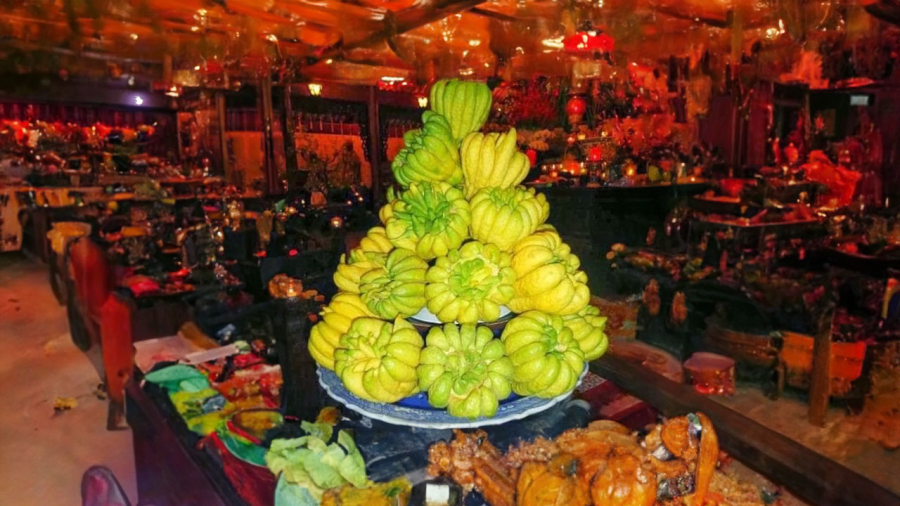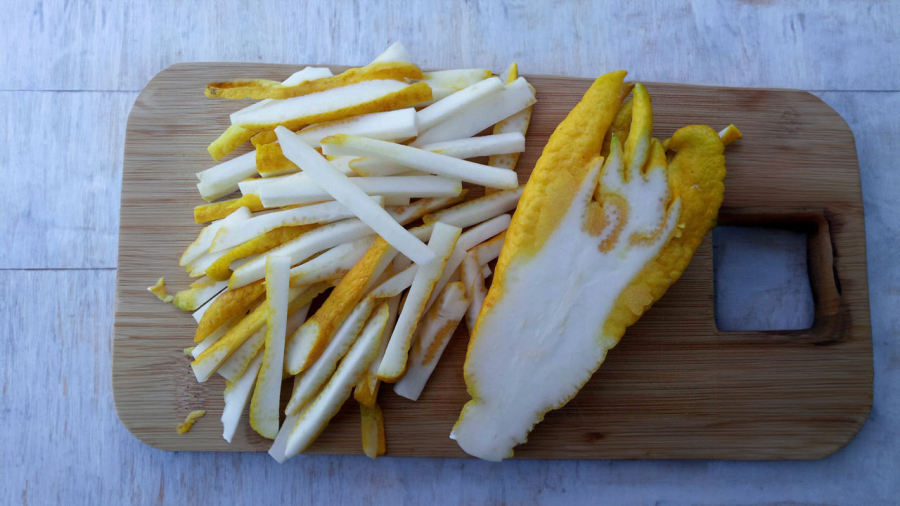Phật thủ, also known as Buddha’s hand, is a popular choice for incense offerings due to its fragrance and its shape resembling Buddha’s hand embracing and protecting. Nowadays, Buddha’s hand is grown in many places as both an incense offering and a feng shui plant, believed to bring good luck and auspiciousness.
The leaves and fruit of Buddha’s hand have a fragrance similar to that of citrus fruits. However, Buddha’s hand does not have pulp, only white rind and pith, so many people think that it is not edible.
According to Traditional Chinese Medicine, Buddha’s hand has a warm, bitter, and pungent taste, which is good for the lung meridian and helps to transform phlegm. The fruit of Buddha’s hand has medicinal uses for conditions such as intercostal pain, upper abdominal pain, nausea, vomiting, cough, bronchial asthma with abundant sputum, and dyspnea.
Buddha’s hand can be used fresh or dried. It can be prepared as a decoction, brewed as tea, or used in cooking, such as in soups or stews.

Some dishes and remedies made from Buddha’s hand include:
– For treating cough, chronic bronchitis: Take 6g of Buddha’s hand along with 6g of Ban Xia rhizome, decoct and drink multiple times a day. If you don’t have Ban Xia rhizome available, you can use Buddha’s hand alone.
– For stomach fullness, poor appetite, nausea, vomiting: Take 3-10g of Buddha’s hand decoction or infuse in alcohol for adults to consume.
– Buddha’s hand-infused liquor helps to enhance cognition and reduce depression: Soak 30g of Buddha’s hand in 500ml of white liquor for 7-10 days. Drink no more than 40-50ml at a time.

– Buddha’s hand syrup: Wash 15g of Buddha’s hand, finely chop it, and add an appropriate amount of sugar to a teapot. Pour boiling water and steep to drink as a tea substitute. It can be used for abdominal cramps caused by bloating. Alternatively, you can soak Buddha’s hand in rock sugar, cook it thoroughly to make syrup, and store it in a cool place for later use.
– Buddha’s hand porridge: Use about 15g of Buddha’s hand to boil water, remove the residue, and add rice to cook into porridge. Season with salt or sugar according to taste. It can be used for fever, cough, and chest pain caused by pleural effusion.
– Buddha’s hand tea: Take 10g of Buddha’s hand, rinse it, finely chop it, and infuse in boiling water to drink as a daily substitute for tea. It can be used for patients with gastric and duodenal ulcers, gastroesophageal reflux, bloating, nausea, and vomiting.
– Buddha’s hand and Coptis chinensis tea help to enhance vision and brighten the eyes: Take 60g of Buddha’s hand, 15g of Coptis chinensis, and 3g of tea. Cook Buddha’s hand and Coptis chinensis together to make a concentrated decoction, then pour it into a warm teacup with the prepared tea. Drink one cup a day, for 5-7 days per session. This type of tea helps to enhance vision and brighten the eyes, especially for elderly people and those with ocular paralysis.
– Buddha’s hand and pig’s heart stew: Use the uppermost section of a pig’s heart, a good-quality piece, clean it, and add 20g of Buddha’s hand to stew. Season with spices to taste. This dish is beneficial for women with leukorrhea and deficiency of blood due to dampness. Consume it 2-3 times a week continuously for 2-3 weeks.
With all these benefits, after offering Buddha’s hand incense, you can dry the remaining fruit thinly and use it to make tea gradually.
2023 Lunar New Year Gift Ideas for Older Family and Friends
As 2021 approaches, families worldwide are gathering to celebrate the special bond between grandparents and their grandchildren. To show their love and admiration, these thoughtfully chosen gifts will bring a smile to the face of the elderly. Here, we have compiled a list of the 13 most meaningful Tet presents that can bring joy to our beloved grandparents.






































